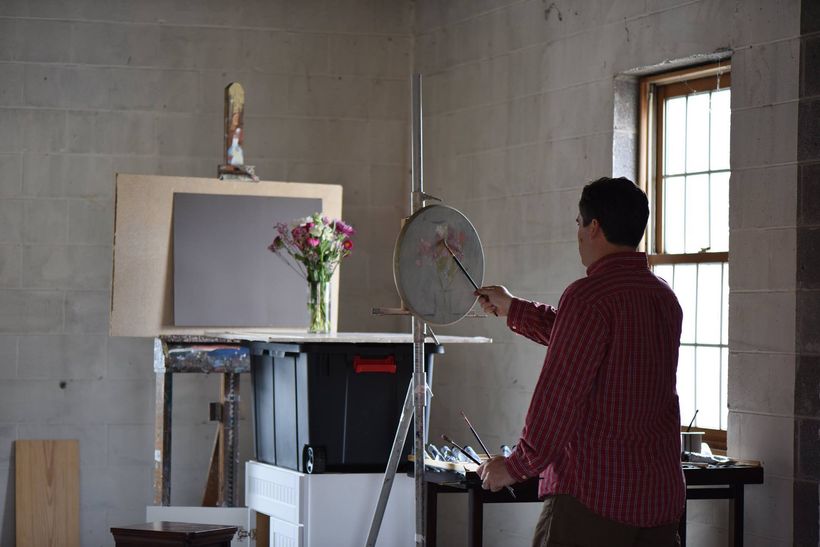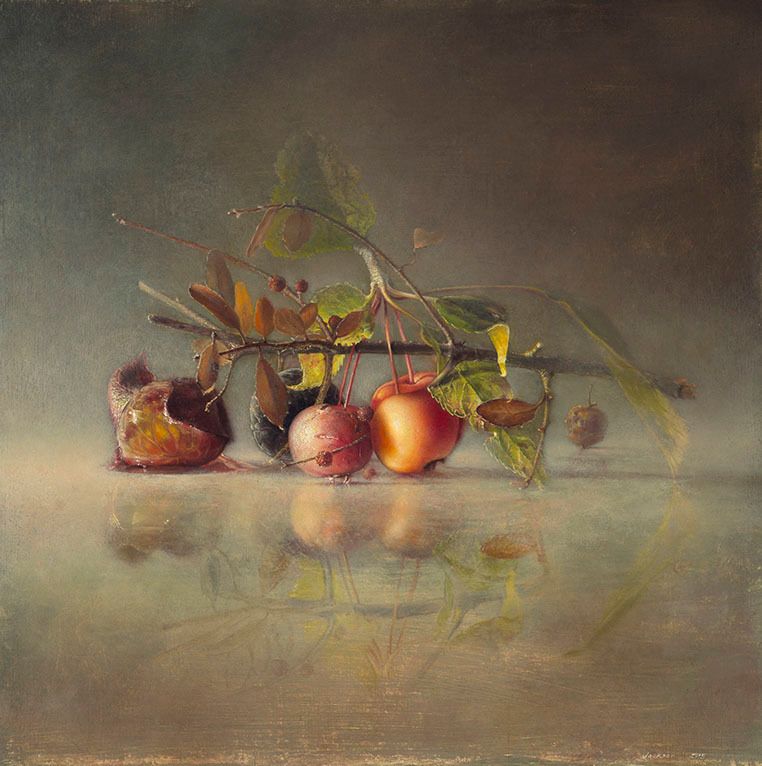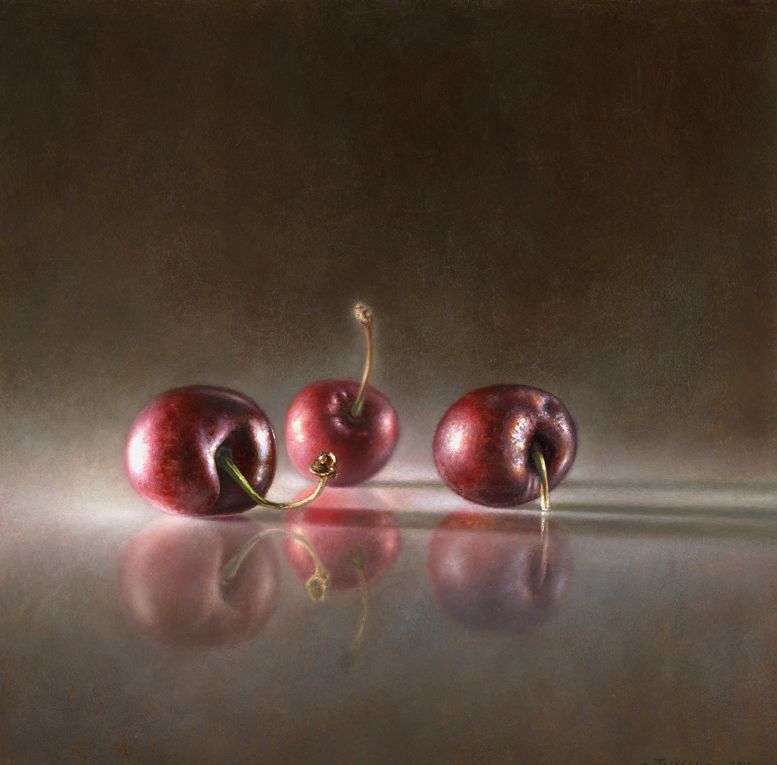© COPYRIGHT 2017 PHILIP R. JACKSON.
Philip R. Jackson, an Associate Professor of Art at the University of Mississippi, is a contemporary still life painter who is extending the vanitas tradition by making images that suggest both the presence of life and its brevity. Jackson’s most recent series, titled “Transitory Spaces,” deals with various aspects of time including aging, displacement and the context of physical objects in relation to space and each other. There is a spiritual quest motivating the artist, whose works are both visually acute and philosophically challenging.
I recently interviewed Jackson, whose works are included in the current “Mississippi Invitational,” on view at the Mississippi Museum of Art.
John Seed Interviews Philip R. Jackson
© COPYRIGHT 2017 PHILIP R. JACKSON.
Tell me about your early life and how it shaped you.
I am from a family of Appalachian ministers and singers: in fact, I am a sixth generation minister. From a young age I was raised to have a deep respect for church life, spiritual conviction and an eternal outlook. As my family and I traveled with my father in revivals, I carried a sketchbook and drew as my father preached. It was my way of recording what he was preaching about. I wasn’t raised around artists or exposed to the history of art.
In my mind, art was merely something I did, but I would later realize it was my personal link to learning and communicating. I remember in the 5th grade I won my first art competition for a cave painting reproduction I created on a brown grocery bag. This was the first time I learned about my abilities and interests in being an artist.
© COPYRIGHT 2017 PHILIP R. JACKSON.
How did your studies — in Ohio and Florence — affect the development of your art, and who were your mentors?
While attending CCAD (where I earned a BFA degree) I was most impacted by my professor Lowell Tolstedt. I remember the first time I ever saw his work; I had never seen an artist present such ordinary subjects in a still life in such a magnified and unique way. Upon further inspection, I discovered that these highly realistic paintings were in fact colored pencil drawings. Tolstedt’s work had a lasting impact on the way I would begin to examine my own subject and to reconsider still life as a viable subject. He taught me the value of subtle persuasion through use of an unlikely subject.
When searching for graduate programs, I sought out to study with painting professor, Dennis Wojtkiewicz at Bowling Green State University. As I researched graduate programs it was obvious that studying with Dennis (since he was a realist and still life painter) offered a rare opportunity to continue my interest in realism and the still life. Like Tolstedt, Dennis shared the rare ability to make the insignificant monumental. When I interviewed for the program one of his selling points was the opportunity to study in Italy–done deal! I had only seen a few master works and most of the works of art I studied in art history classes had only been viewed by a projector or reproductions. It was this trip that completely changed my outlook about painting. The program in Italy was through SACI and was located in the center of Florence.
While in Italy we traveled, visiting cities like Cortona, Pisa, Sienna, and the island of Elba. Before and after our trip to Italy, a friend of mine and I backpacked throughout Europe and Spain, visiting every major museum in London, Paris, Barcelona and Madrid. We saw some of the greatest masterworks we had ever wanted to see. While we were in London, amazingly two retrospectives of my most influential painters, Vermeer and Morandi, were simultaneously exhibiting at the Tate Modern and the National Gallery.
Seeing these paintings of both Vermeer and Morandi in person—along with all of the other masterworks we viewed on our trip—altered the way I thought about paint as a medium and content within my work. Up until this point, my paintings had a flatness to the surface and my process was more of an excuse to replicate an image than to understand my subject. After my experience studying abroad, I was challenged to approach my work with a more physical presence. This realization still continues to form the way I build a painting and deal with my subject.
© COPYRIGHT 2017 PHILIP R. JACKSON.
You mention in your artist’s statement that you see things in pictures and have always been attracted to detail. Tell me more about this...
William Blake says it this way: to see a World in a Grain of Sand—- And a Heaven in a Wild Flower—- Hold Infinity in the palm of your hand—- And Eternity in an hour....
For me the action of seeing is not overlooking the familiar to find something unique, but rather having the ability to engage with the familiar through fresh eyes. So, the abstract nature of time and temperance of life — these topics are so broad that it is through painting the details of my objects that allow me to communicate specifics beyond generalities. The vividness of my paintings allow for a sensory experience beyond photographic reproduction. The tactile surfaces and atmospheric spaces physically work in tandem to create a new reality.
© COPYRIGHT 2017 PHILIP R. JACKSON.
How do still lifes serve to reveal your ideas and emotions?
My paintings begin with an extended observation and are motivated by my infatuation with objects. I spend a great deal of time understanding my chosen objects before I ever enter into painting them. These objects, taken from nature, take on a new life through our observations. When they are placed on the tabletop and given a source of light, what is seen is the poetry of a place: the essence of an object’s life within the natural environment. These forms are no longer just pears, apples, and cherries, but become reflections of our presence, our space, and our existence. I use the still life as a vehicle, not as a subject.
In my still life paintings I capture the landscape through the history of the object created by its environment. By removing the object from its ecological setting and placing it in a space absent of time, it’s natural purpose is redefined. The object becomes the place. Just as a map reveals the typography of the terrain, objects reveal the signs of a life lived. Imbued with a human-like presence, these congregated objects reveal a newly formed relationship by the exchange between them. It is as if they have been having a conversation long before our approach to the picture.
It is in that transformation from a familiar object to their assumed new role that they offer a reflection of our reality. William Bailey says about his work, “Realism is about interpreting daily life in the world around us. I am trying to paint a world that is not around us.” To that end, I am interested in creating paintings that inhabit that spirit of thinking. Just as people entering a room overlook the small things, I see a present spiritual reality coexisting with our natural world. In the new testament of the Bible, Paul the Apostle states: “While we look not at the things which are seen, but at the things which are not seen: for the things which are seen are temporal; but the things which are not seen are eternal.”
While the objects in my paintings are in a present state of transition, it is my hope that what the viewer is left with is not so much the physical shell of the object, but the spirit that embodies them.
© COPYRIGHT 2017 PHILIP R. JACKSON.
Can you tell me in some depth about one or two of your recent paintings?
Pear, Apples, and Cherries presents a seemingly traditional collection of naturalistic objects congregated together to form the likeness of a family portrait. My wife and each one of my children’s lives are reflected in all of my paintings. In Pear, Apples and Cherries, the pear is a matriarchal presence over the clustering apples and cherries. Just as a mother hen broods over her young, she is both protective and intimately nurturing to each object as she stands above them. Their lives are reflected through the surface. The mysterious elements in the periphery contain the unknowns that we encounter in our life. I, as the artist, in the place of the viewer, am the voyeur, looking back, watching over them within this small intimate space. This painting is like a brief glimpse into a collection of memories.
© COPYRIGHT 2017 PHILIP R. JACKSON.
In the last two years, while working on my more elaborate paintings, I have begun an undercurrent of one–session paintings that explore the effects of light. After revisiting the paintings of artists that have influenced my work, specifically Gorgio Morandi and Walter Tandy Murch, I was reminded of something very magical I have always admired about both artists. Morandi and Murch share many commonalities within their work both centering on the effect of light and the act of looking. Murch wrote a statement about his personal approach that resonated with me. “I must not paint the thing itself, but will paint the air between myself and the thing and beyond.” This statement challenged both the way I observe and translate my subject.
This inquiry led to this current series of paintings that explore the atmosphere in and around the object and a fleeting light. They are painted under natural daylight at the end of the day when the light is at its most vulnerable state before it dissipates. In capturing this effect, the immediacy of that moment is poetically reflected in a lively application. As the light fades, edges blur creating an effect of a dense fog or rainstorm. The paintings are becoming more about capturing a transitory environment than the life cycle of an object.
© COPYRIGHT 2017 PHILIP R. JACKSON.
Tell me about your current exhibition
The Mississippi Invitational is a biennial exhibition hosted by the Mississippi Museum of Art, in Jackson, Mississippi. This exhibition surveys recent developments by contemporary visual artists living and working across the state.
In addition to exhibiting in the Mississippi Invitational exhibition, one artist is selected for The Jane Crater Hiatt Artist Fellowship for which I am the recipient. This fellowship was created by Jane Crater Hiatt and her late husband Wood in response to the need to nurture and invigorate the arts in the state. This grant of $15,000 was awarded specifically to me for a proposed residency in Ireland.
“We’re honored to share Jane Hiatt’s vision and commitment to Mississippi artists through this prestigious fellowship,” said Betsy Bradley, director of the Mississippi Museum of Art. “Because of her generosity, Hiatt fellows have the opportunity to travel the globe, evolve their art practices and bring exciting new ideas and aesthetics back to the state.”
What are your interests outside of painting?
I am a husband, father of three (all under the age of 10), minister, painter and a full time professor. What time is there left? In all seriousness though, my family, my ministry, and my role as a professor are central to my art and life interests.
© COPYRIGHT 2017 PHILIP R. JACKSON.
As a Professor of Art, what advice do you give to your painting students?
I thought it might me more fitting to allow one of my graduate students to answer this question, here is her response:
There will always be someone better, but no one can say they work harder than I do, words Philip Jackson mentions on occasion but lives every day. He is an artist first, yet a professor too, teaching by example and guidance that you must devote yourself fully to your work to succeed. Pretty paintings are not the goal he sets for his students; he urges us to be intense observers, constant lookers, seeking not to paint the object as everyone sees it, but how we would have them see it.
- Brooke Alexander, MFA candidate, The University of Mississippi
Exhibition Information:
Works by Philip R. Jackson are included in the 2016 Mississippi Invitational along with works by 17 other contemporary artists working in Mississippi. The exhibition will be on view at the Mississippi Museum of Art in Jackson from December 17, 2016 to March 12, 2017.









